Medieval Ages
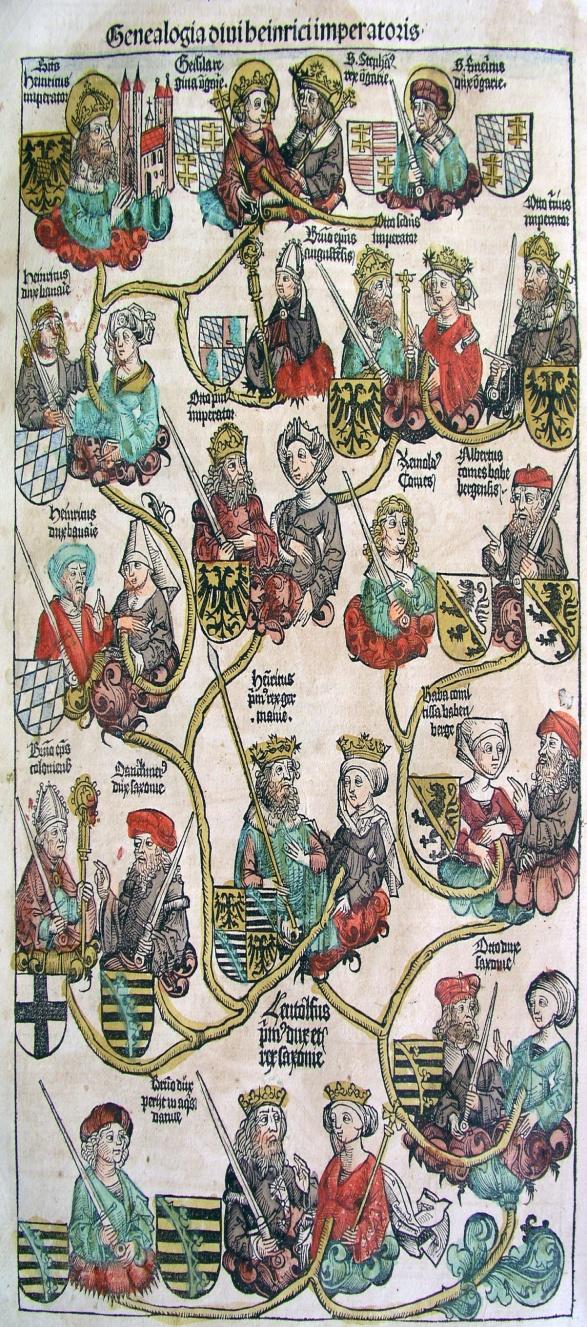
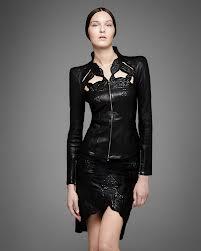
The medieval town was a common outfit normally worn by the women within the upper class of medieval English society. As seen in the example “Genealogy of Henry II (1440-1514)” there are varying examples of women wearing the medieval gown in what seems to be a fairly standard design. The design consists of long sleeves that are attached to a long one-piece outfit that just slightly shows the neck and upper half of the woman’s body but entirely covers up her lower half.
It is quite interesting to note that due to the genealogy example utilized, we can see a slight “evolution” in the style of medieval gown wherein the sleeves while remaining the same length” appear to be getting longer and wider. In comparison, the modern-day version of the medieval gown seems to be an overly exaggerated version of the original. First off, while it is true that the style of the original version emphasized long sleeves, they were not as large as compared to their modern-day counterparts.
The sleeves on the modern-day contemporary version seem to be far too exaggerated to be functional. Not only that, while it may be true that the original version of the medieval gown had several layers, the original example showed that the innermost layer only showed itself on the top of the outfit near the neck while the rest of the layers that were worn were covered up by the outermost layer. In comparison, the modern-day version clearly shows the inner layer with the separation beginning at the navel of the model.
Considering the overly conservative nature of members of the upper class during the Middle Ages, such a style would have been relatively unheard of and, as such, the style of the modern-day medieval gown reflects the more “liberal” thinking that exemplifies present-day styles and attitudes.
16th Century
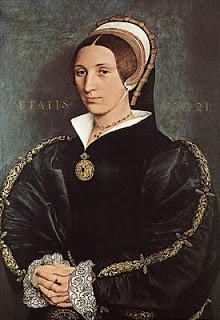
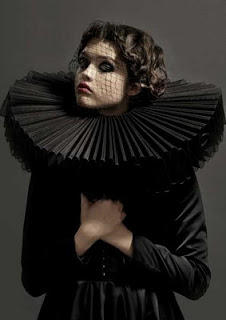
Painted sometime between 1511 and 1563, this painting of Lady Elizabeth Ughtred-Cromwell, the younger sister of Queen Jane Seymour, shows one of the distinct styles of the 16th century. What is immediately apparent from the given example is that the style of the upper dress makes a person look huge. The sleeves are overly large and seemed to be stuffed with some sort of cloth. The chest also appears to have been significantly expanded and even though she’s a woman, Lady Elizabeth Ughtred-Cromwell looks like she has overly large broad shoulders.
In comparison, the modern-day equivalent of the noble gown has far more conservative sleeves and shoulders and does not make the wearer appear as if they had disproportionally massive arms and shoulders. When examining the style of the noble gown during the 16th century, it can be assumed that one of the reasons behind the overly large style was in part to make people born of “noble blood” stand out in terms of stature and presence.
An examination of other outfit styles during this period for “commoners” showed a distinctly more conservative style that lacked the overly “puffy” and exaggerated looks that were quite common for both noble-born men and women alike during this period. The difference between modern and past styles, with the modern version surprisingly being more conservative, is most likely in part due to the current perception involving obesity. The current revulsion and social ostracizing of individuals that have been deemed as overly obese is a relatively recent phenomenon that has only occurred within the past 100 years.
While obesity has existed in one form of another in humanity’s past, it has taken on different meanings with people in the 16th century often connoting obesity as a mark of social distinction which indicates that an individual has more than enough to eat and can eat excessively. Such a concept might have been passed along into contextualizing size with wealth and nobility resulting in the creation of fashion styles that focus on making a person seem “larger than life” so to speak. Since such a distinction does not exist at the present, it is not surprising that the modern-day version of the noble gown does not adopt such a stylistic element.
17th Century
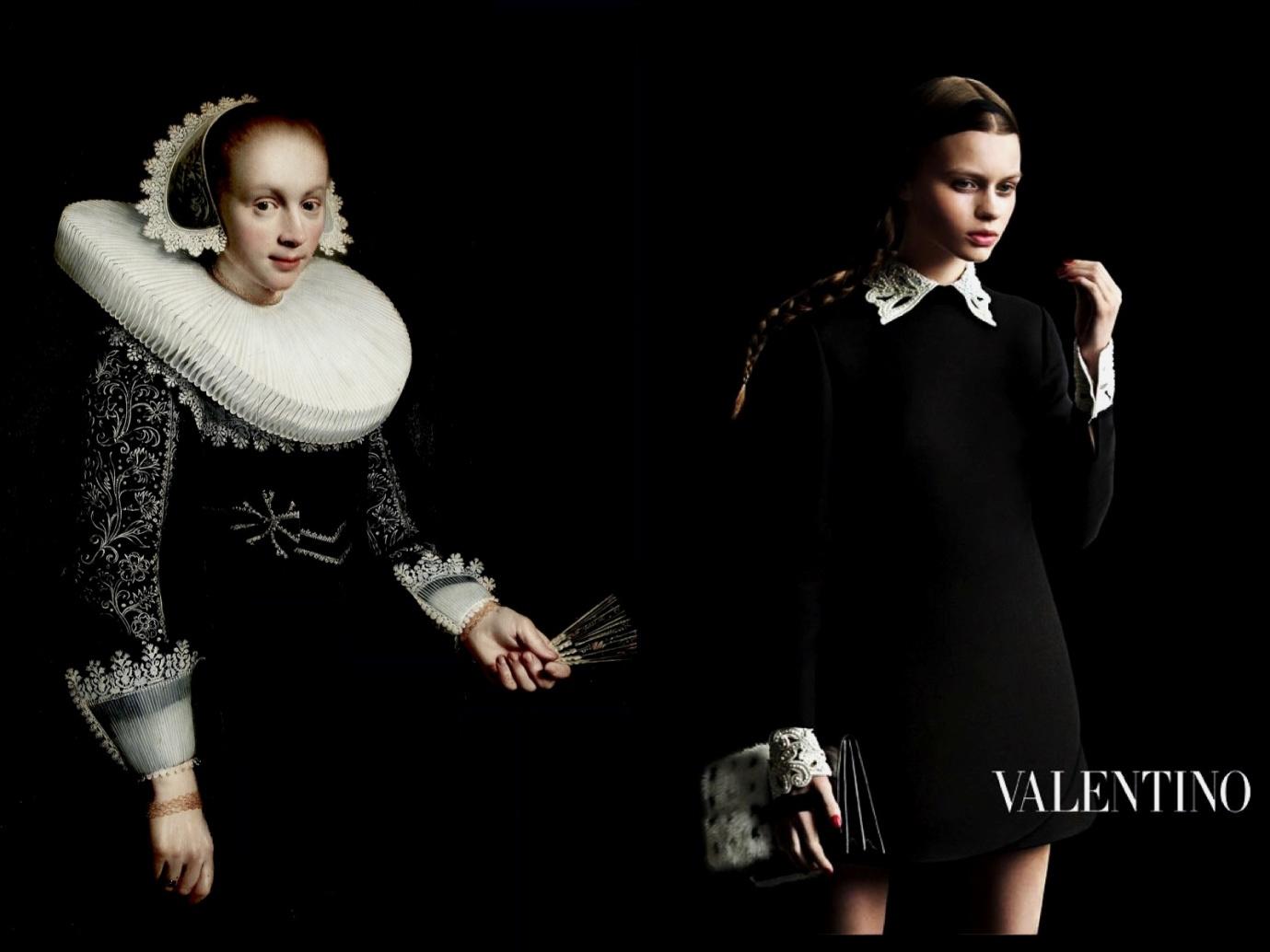
To properly examine the styles utilized in the 17th century the example: “Portrait of a Young Woman with Fan” by Jan Daemen Cool (1636) is being used along with its modern equivalent created by the brand Valentino. While both dresses appear to utilize similar levels of conservatism when it comes to the sleeves, that is where the similarity ends with the Valentino version showing a more sexual style as compared to its 17th-century counterpart.
What must be understood is that the Puritan movement in England during the 17th century resulted in the promotion of widespread conservative practices which affected how people dressed. This resulted in the popularity of clothing that de-emphasized aspects related to sexuality and instead promoted a form of “blandness” so to speak in the manner in which people dressed and behaved. As it can be seen in the portrait, the only item which can be considered “unique” is the neckpiece which is overly large, however, within the context of the 17th-century society within England, it was considered to be the height of fashion since it combined the “larger than life” aspect of fashion seen in 16th-century fashion with more conservative body enclosing dresses.
In comparison, the Valentino version does not attempt to hide the contours of the body; rather, it emphasizes it and seems to combine a degree of sexuality with the conservative style of the dress. This can be seen by how the dress hugs the hips of the wearer and is tantalizingly high on her legs. When looking at the two dresses, it can be seen that aspects related to form and function that inspired the dressed are different wherein the 17th-century dress emphasized adherence to strict societal rules whereas the Valentino version seems to focus on emphasizing sexuality and femininity.
18th Century
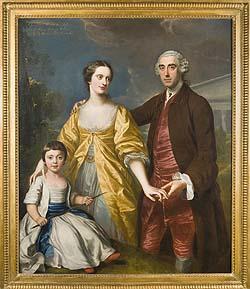

18th-century fashion diverges significantly from its counterparts in the 16th and 17th centuries since it no longer places as much emphasis on conservatism. As can be seen in the portrait “The Pitt Family of Encombe” by William Hoare, a greater emphasis is placed on the functionality of the material rather than its overall appearance. Lighter fabrics are utilized and the bosom of the woman (i.e. the upper part of her chest) is exposed.
This is in direct contrast to the styles utilized during the 16th and 17th centuries where any hints towards sexuality are often covered up by layers of clothing. One of the reasons behind this sudden shift could be related to the continued expansion of the various colonial powers at the time into different regions around the world which resulted in an influx of foreign influences that impacted how people started to dress. Another potential reason behind this is connected to the spread of European colonialists to various areas that were hotter and damper as compared to the environments that they were used to.
As a result, many of them became uncomfortable with the styles they were utilizing and simply opted to wear clothing that was more suited for their new environments. Regardless of the reason behind the adoption of more revealing clothing styles, 18th-century fashions are closer to their modern-day counterparts as seen in the example provided. While it may be true that their modern-day equivalents are far more revealing, the fact remains that there are more similarities rather than differences. Modern-day clothing that was inspired by 18th-century clothing styles does still have a level of conservatism adapted into them as seen in the case where the outfits starting from the breast going down fully enclose the woman wearing them.
However, it is usually the case that the upper half of the body, starting from just above the breasts, is exposed. This makes the style far more “sexual” based on the amount of exposed flesh that is shown. From a certain perspective, when examining all the past styles and looking at them from era to era, it can be seen that one trend that seems to be present in all the styles is a certain predilection for women’s fashion for high society individuals to contain a certain level of flamboyancy.
Works Cited
“Friday Follow: 18th Century Inspired Fashions”. 2014. Web.
“Inspiration 17th century Dutch paintings Valentino FW 201-14”. 2014. Web.
“New investigation into a portrait of an unknown English Princess“. 2014. Web.
“Term of the day – GENEALOGY”. 2014. Web.
“The Pitt Family of Encombe by William Hoare”. 2014. Web.
“Medieval Inspired Fashion in Jitrois Spring 2013”. 2014. Web.